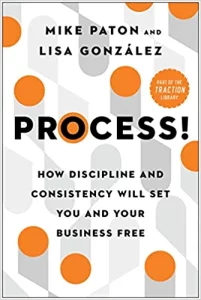Chapter 5 – The FBA Checklist, page 95.
- To begin consistently getting the results you want, you must permanently change the way people do things in your business.
- Completing a four-step checklist and then repeating that checklist is all that is required.
The Four-Step Checklist
1. Train
- Train every employee who performs one or more steps in a core process.
- Everyone must have a chance to walk through the process, ask clarifying questions, and even push back or poke holes.
- When your team truly understands each step in the process as well as the big picture, they’ll be more likely to help you move forward rather than dig their heels in.
- If you and your team have a regular Meeting Pulse (weekly L10), you may be able to complete the initial training without adding another meeting.
- A growing number of companies use online training programs with robust learning management systems to track progress.
- Be patient, old habits die hard.
- Training Industry Magazine explains, that training alone won’t change behavior, largely due to something called the “forgetting curve.”
- Studies suggest we forget up to 90 percent of new information within 30 days, and 70 percent of that loss happens within the first 24 hours.
- Two great ways to reinforce training, increase retention, and truly change behaviors are the next two steps in the FBA Checklist – measure and manage.
2. Measure
- “If you cannot measure it, you cannot improve it.” – Lord Kelvin
- Measure performance to ensure people are doing things right, doing them often enough, and getting the desired results.
- As Leadership Team, we must determine which steps in each process to measure and exactly what type of measurement makes sense for each step:
- Compliance – Are we doing it the right way?
- Frequency – Are we doing it often enough to get the desired result?
- Outcome – Are we getting the desired result?
- The Company Scorecard:
- Leadership Teams of companies running on EOS spend five minutes each week reviewing a company scorecard.
- Great scorecards contain 5-15 leading indicators that predict future results.
- As a result, leaders can react quickly to off-track measurables rather than waiting for the results to come in at the end of the month or quarter.
- A Leading Indicator is an activities-based number that when repeated properly, produces a desired result.
- Since a Core Process, by definition, is a series of steps/activities that produce a desired result, the major steps/activities in each process become a great candidate for measurables on a weekly scorecard.
- IDS off-track measurables first.
- Therefore, many companies discover that strengthening their company’s Process Component also helps strengthen their Company’s Data Component.
3. Manage
- “Effective leadership is putting first things first. Effective management discipline, carrying it out.” – Stephen Covey
- Training your people is important, and measurement provides reinforcement, but effective leadership and management is truly the key to changing behaviors and ensuring each of your core processes is followed by all.
- Now is time for everyone who leads and manages in your organization to turn their new way of doing things into automatic habits, thus creating what Jim Collins describes as a culture of discipline.
- Start by giving clear directions. Help your people understand why this new way of operating is valuable and how succeeding will benefit not only the company but also every one of its employees.
- When they resist or complain, listen carefully and seek to understand their concerns.
- Be prepared to reiterate the reasons for changing and to offer support along the way.
- Provide team members with the necessary tools to permanently change their behavior:
- Make it easy to access documents, checklists, and videos.
- Make it easy to receive initial and ongoing training.
- Make it easy for them to find support when feeling stuck.
- Make yourself available.
- Provide clear expectations and goals.
- Coach instead of punishing.
- Check-in and ask employees if they have everything they need to be successful.
- Get comfortable repeating yourself.
- Practice listening.
- Seek to understand their challenges.
- Show appreciation along the journey to reinforce new habits.
- Celebrate them as often as possible.
- Carve out time for one-on-one coaching.
- When every member of your team understands the reasons for change and feels heard, valued, and supported on their journey, permanent change is possible.
4. Update
- “It is not the strongest of the species that survives, not the most intelligent that survives. It is the one that is most adaptable to change.” – Charles Darwin
- Update each process regularly (at least once per year), to stay current and continue improving.
- Updating your processes regularly creates a culture of continuous improvement.
- When updating processes, look for opportunities to:
- Correct mistakes
- Eliminate steps
- Remove inefficiencies
- Streamline
- Simplify
- Automate
- Delegate
- Updating your process is critical to survival:
- Society is changing
- Your industry is changing
- Your customer’s needs are changing
- Technology is changing
- The workforce is changing
- Successful leadership teams manage the update step of the FBA Checklist in several ways, but all of them involve accountability and a calendar:
- Make sure one member of your leadership team owns each process.
- The appropriate choice for the assignment is often clear as it is tied to their role in the Accountability Chart.
- Use your calendars or software to remind process owners to update their process at least once per year.
- When updating a process, be sure to include all stakeholders who participate in the process.



